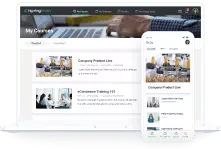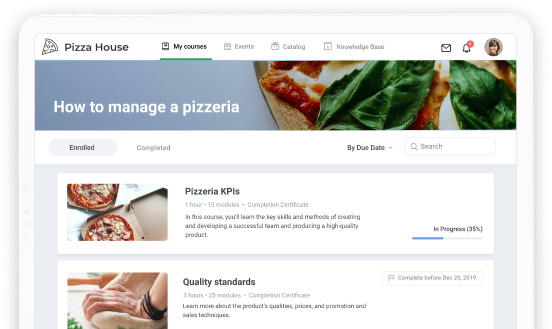Continuous Learning: How to Maximize Your Human Resources

In today’s business, the only constant is change. To keep up with the times, companies need to continually upgrade their systems, implement new technologies, help their employees learn new skills, and invest in their professional development. One of the most effective tools for sustaining growth in this fast-developing world is providing continuous employee learning. So, if you want to maximize the human resources you have, see how you can introduce continuous learning into your corporate culture.
What Is Continuous Learning?
Continuous learning is the process of constant skill and knowledge development. It may be on a personal level (lifelong learning) or on a professional one – training programs, career development, social learning, etc.
What Are the Goals of Continuous Learning in Business?
Every company sets its own goals and objectives of continuous learning depending on what results it hopes to achieve. But there are some common goals:
- Learning and developing new skills
- Increasing professional competence
- Professional development
- Adapting to changes in the world and the work environment
- Developing employees’ talents
Importance of Continuous Learning
Continuous employee training can yield a number of potential benefits to the company:
- Enhanced performance and productivity. Training gives employees a better understanding of their responsibilities within their role, and how to achieve positive outcomes. This helps them work more productively on a day-to-day basis, respond more quickly to customer needs, and meet future demands in the marketplace more effectively.
- A competitive edge in the market. By constantly gaining new knowledge and developing skills, staff members stay current with industry changes. Employees who are competent and on top of changing industry standards will help your company stay ahead of the competition.
- Higher return on investment. Employee training requires some investment, but if it is aimed at the company’s business goals, there can be a fast payback. The initial investment can be recouped through improved employee performance and an increase in revenue.
- Reduced employee turnover. Corporate training can boost employee retention. People who see the company investing in their learning are 30-50% more likely to keep on working at the same organization. Training is a great way to retain valuable staff members, especially for companies that are constantly searching for new talent. Many millennials won’t work for companies that don’t offer learning and career development options.
- Greater customer loyalty. Well-trained and engaged employees interacting with customers can create your biggest brand advocates. They know how to present a product and are enthusiastic in dealing with the audience. This improves customer experience and increases customer loyalty.
3 Main Areas of Corporate Continuous Learning
Training programs are tailored to the company’s specifics, its business needs, and strategic goals. Still, there are several content focus areas common for all organizations:

Let’s take a closer look at them.
1. Onboarding
This is a “boot camp” for new employees that helps them integrate into the new work environment faster. Through onboarding, they acquire the skills, knowledge, and behaviors needed to become productive ASAP. The program is usually prepared by an HR manager on big-picture topics such as the company’s history and its corporate culture, basic policies, health and safety regulations, and other information which should be known by each employee. This kind of training is relevant to all roles and departments throughout the company.
2. Job-specific training
Such a program may occur often, but not necessarily regularly, depending on the particular job position or department. This is what is required to be up to date and proficient on an ongoing basis. The program can include product and service training, new skills training, and motivational training.
For example, let’s say the сompany is constantly expanding its product line, and as a result, sales reps have to update their knowledge after each release. Or, tax laws change often, so an accountant must receive yearly training on new tax codes.
3. Managerial training
This kind of training can help a company build its human resource base. The most successful employees are usually identified as candidates for promotion, and can be assigned to managerial training. Topics might include anything from product knowledge to leadership skills, such as how to motivate and delegate, give feedback, and manage teams.
Continuous Learning or Continuous eLearning?
Live classes, seminars, and workshops are still popular training techniques, but online learning can become a better fit for employees as it paves the way for just-in-time learning. Access to content “anytime, anywhere” is exactly what a modern learner needs, especially if it’s not a one-time event.
Let’s have a look at what the statistics say. Is corporate digital learning really worth the investment?

Besides, with eLearning, you can automate employee training. And this means you’ll be able to eliminate repetitive tasks such as explaining to new employees which learning materials they should study, checking tests and collecting statistics manually, and sending notifications about the upcoming training.
All these facts – together with the colossal amount of money companies save on training costs – illustrate that online learning will most certainly bring you a great return on investment and will help you drive your company’s success.
Continuous Learning in Business: Examples
Many understand that continuous employee development is important to business success, but some organizations are still unwilling to invest in human capital. Let’s have a look at some companies that went for it and succeeded.
Pixar
Pixar Animation Studios has a school called Pixar University, where its employees can attend free classes. The company allows its employees to skip work and take group lessons in different subjects. The regular training program hosts about 14 social and interactive sessions per week, including drawing, painting, acting, improvisation, animation, ballet, and live-action filmmaking.
IBM
IBM provides employees with continuous video-based learning. There’s an entire YouTube channel where the training department shares video tutorials, interviews, messages from executive leadership, and other relevant learning materials. The content varies from live-action videos to animated and screen-recorded lectures.
PayPal
PayPal supports social learning. They have a private group on Facebook where mentors upload learning content and host short classes. For more in-depth learning, the company uses Udemy for Business. Employees browse its library of over 2,500 courses and study the content on their own schedule.
Also read: Mentorship Program: All You Should to Know in 2023 [Expert Insights]
MOXA
MOXA delivers continuous learning to digital marketers around the world with the help of a learning management system (LMS). They create courses about content marketing and social media marketing with the iSpring Suite, eLearning authoring toolkit, upload them to iSpring Learn LMS, and assign them to marketers from different affiliates. This approach to learning allows the company to provide higher-quality training with consistency when they roll out new materials. Read the full case study →
To Sum Up
As you can see, continuous learning is an essential part of keeping up with a permanently changing world, working environment, and numerous new developments. That is why it has become such a popular practice in large companies. They use different training methods, but most of them tend to train their employees online using a Learning Management System (LMS). This approach saves time and money, allows them to eliminate repetitive tasks, improves employee engagement, and increases employee retention.
Would you like to experience the benefits of an LMS for your employees’ continuous learning? Get an iSpring Learn free 30-day trial and explore all of the LMSs features right away. Good luck!










